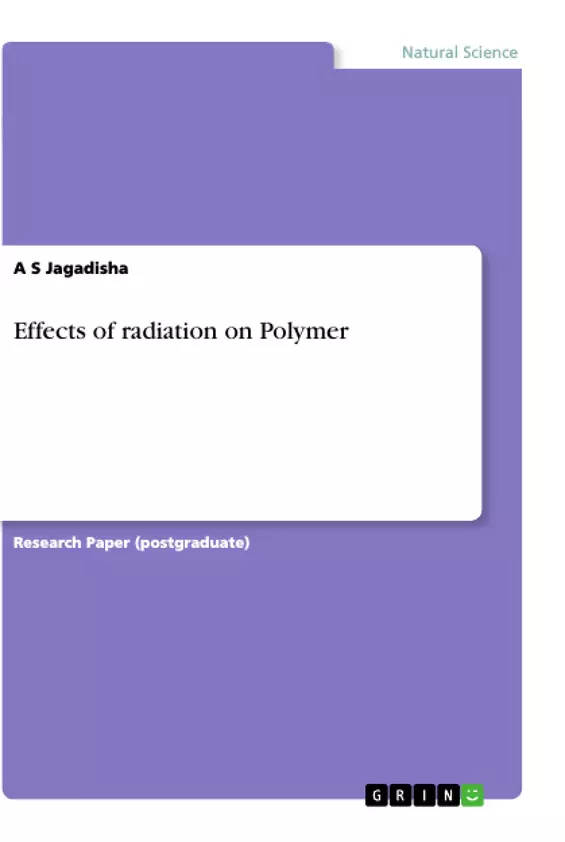Over the past decade a great deal of information has been published about intrinsically conducting polymers, more commonly known as "synthetic metals". The basic interest comes from the fact that these new materials combine the physical and chemical attributes of plastics with the electrical, electronic, magnetic, and optical properties of metals or semiconductors.
Poly (vinyl chloride) (PVC) is extraordinarily useful as a commercial material. Among the thermoplastics, it ranks second only to polyolefins in total worldwide production volume. Remarkably, it has achieved this status despite its molecular instability toward heat, an instability that is much more pronounced than those of all its major competitors. In a technological sense, this difficulty has been overcome to a large degree, for otherwise the usage of PVC would never have reached its current level Commercial interest in PVC was first revealed in a number of patents independently filed in 1928 by Carbide and Carbon Chemical Corporation, Dupont and IG Farben.
From the present research studies, it is summarized that the characteristics of poly vinyl chloride [PVC] changes according to the dosage of electron beam irradiation. That is amorphous nature of PVC changes to crystalline and conjugate double bond and free radicals are formed due to the degradation. The free radicals formed due to scission process in responsible at higher energy radiation. The electrical conductivity of polyvinyl chloride after irradiation slightly increases with electron beam radiation dose. It is due to increase in crystallinity in the polyvinyl chloride after electron beam irradiation and production of free radicals due to scission or crosslinking in PVC.
Inhaltsverzeichnis (Table of Contents)
- INTRODUCTION
- 1.1 Introduction to polymers
- 1.2 Orientations of the work
- 1.3 Scope
- RADIATION EFFECTS ON POLYMERS
- 2.1 Introduction
- 2.2 Radiation sources
- 2.3 Microtron
- 2.4 Terminology and units
- 2.5 Radiation induced chemical changes in polymer
- EXPERIMENTAL METHODS
- 3.1 Preparation of sample
- 3.2 Thickness measurement
- 3.3 Irradiation
- 3.4 Electrode coating
- 3.5 X-ray Diffraction
- 3.6 Calculation of crystallinity
- 3.7 IR spectra
- 3.8 Measurements
- RESULT AND DISCUSSION
- 4.1 X-ray Diffraction analysis
- 4.2 FTIR Analysis
- 4.3 Conductivity Measurements
- CONCLUSION
Zielsetzung und Themenschwerpunkte (Objectives and Key Themes)
This work aims to investigate the effects of radiation on the properties of Polyvinyl Chloride (PVC) and explore its potential applications in various fields. The focus is on understanding the changes in molecular structure, mechanical properties, and electrical conductivity of PVC when exposed to radiation.
- Radiation-induced changes in the molecular structure of PVC.
- Influence of radiation on the mechanical properties of PVC.
- The effect of radiation on the electrical conductivity of PVC.
- Potential applications of irradiated PVC in various fields.
- The relationship between radiation dosage and the changes in PVC properties.
Zusammenfassung der Kapitel (Chapter Summaries)
- Chapter 1: INTRODUCTION
This chapter provides a comprehensive overview of the research area, focusing on the background, significance, and scope of the study. It introduces the importance of polymers in various industries, particularly Polyvinyl Chloride (PVC) and its unique properties. The chapter also discusses the challenges and potential applications associated with PVC in electrical and other fields.
- Chapter 2: RADIATION EFFECTS ON POLYMERS
This chapter delves into the impact of radiation on polymers. It explores different radiation sources, terminology, and units used in radiation research. The chapter particularly focuses on the chemical changes that occur within PVC molecules when exposed to radiation.
- Chapter 3: EXPERIMENTAL METHODS
This chapter details the experimental methods employed in the study. It covers the preparation of samples, thickness measurements, irradiation procedures, electrode coating techniques, X-ray diffraction analysis, calculation of crystallinity, infrared spectroscopy measurements, and data acquisition methods.
- Chapter 4: RESULT AND DISCUSSION
This chapter presents the results of the experimental analysis and discusses their implications. It explores the changes in PVC properties observed after irradiation, analyzing the X-ray diffraction patterns, Fourier Transform Infrared (FTIR) spectra, and conductivity measurements.
Schlüsselwörter (Keywords)
The primary keywords and focus topics of this work include: Polyvinyl Chloride (PVC), radiation effects, polymer properties, molecular structure, mechanical properties, electrical conductivity, radiation sources, irradiation, X-ray diffraction, FTIR spectroscopy, conductivity measurements, applications, and industrial significance.
- Arbeit zitieren
- A S Jagadisha (Autor:in), 2010, Effects of radiation on Polymer, München, GRIN Verlag, https://www.hausarbeiten.de/document/520275


